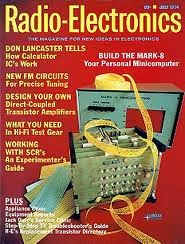 |
| Bugbooks |
The MARK 8 microcomputer designed by Jon Titus and published as a construction article in RadioElectronics magazine July 1974. The MARK 8 was the first construction article about how to build your own microcomputer and was an important part of the home / personal computer revolution.
A big Congratulations to Jon for this 40 year anniversary.
 |
| MARK 8 Computer by Jon Titus |
Comments by John Titus
40 years ago this July--Radio-Electronics magazine published the "Mark-8 Minicomputer" article written by Jonathan Titus as a construction project for people who might want their own computer. The Radio-Electronics cover showed the Mark-8 as Jon built it while a graduate student at Virginia Tech.
"I just wanted my own computer," said Titus. "As a teenager I built a lot of circuits with 24-volt relays and created a brute-force design for a 4-bit binary adder. I didn't know anything about logic or gates, so I just stuck it out until I had a circuit that worked. It took a lot of relays and 6-pole switches! Later I took some classes on digital-logic integrated circuits and created some projects of my own. Don Lancaster's articles in Popular Electronics provided a lot of inspiration and good ideas. Later in grad school I got to use PDP-8/L minicomputers and realized how cool they were and decided to build my own computer. About then, Intel announced its 4004 microprocessor, which could have worked, but I waited for the 8-bit 8008 and jumped in. Intel provided a complicated design for a computer board, so I took it and adapted that design so my computer had a front panel of LEDs and switches. The home-computer era had arrived."
"People have asked how I chose the name 'Mark-8,'" continued Titus. "Larry Steckler, the editor at Radio-Electronics wanted a name for the computer project, so on the spur of the moment I decided on Mark-8. I used the word 'minicomputer' because many people knew small computers such as the PDP-8, Nova, and others. I didn't think 'microcomputer' would appeal to people and no one thought about a 'personal computer.'"
Jon donated the original Mark-8 Minicomputer to the Smithsonian Institution in the 1980s and it became part
of the long-running "Information Age" exhibit.
of the long-running "Information Age" exhibit.
The publication of the MARK 8 computer in the July issue of 'Radio Electronics' was the first time a construction article was available on how to build your own microcomputer. This was noticed by the competing publication 'Popular Electronics' and followed in January 1975 with an article about the "MITS Altair 8800" microcomputer. John was first with the MARK 8 and as a result many computer clubs and newsletters were started to help computer hobbyist build and use the MARK 8.
Here is a the whole article in 'Radio Electronics' from Rich Cini Collector of Classic Computers web site.
Here is a look at five very different variations of how folks constructed their MARK 8 computer.
 |
| David Larsen KK4WW |
It is my pleasure to be a colleague of Jon and have worked together in the "Blackburg Group" for about 12 years.
"by David Larsen" KK4WW Microcomputer Collector/Historian.



No comments:
Post a Comment
I look forward to your comments and will respond.